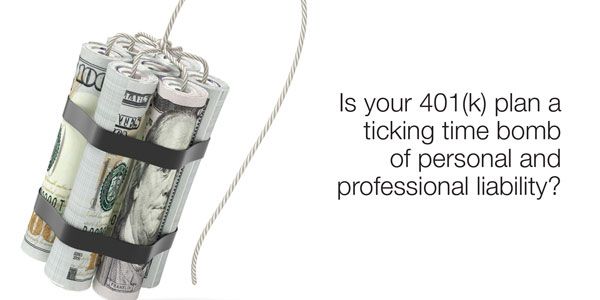Tom Zgainer discusses how small business owners may be overlooking a significant source of liability in their practices: their 401(k) plans
 Class-action lawyers seeking plaintiffs are reaching out to employees in businesses of all kinds with opportunistic letters that highlight how they have been harmed by excessive fees in their 401(k) plans. These letters encourage plan participants to join lawsuits against their employers for breach of their fiduciary obligation to provide a retirement plan that is set up for the sole benefit of the employees.
Class-action lawyers seeking plaintiffs are reaching out to employees in businesses of all kinds with opportunistic letters that highlight how they have been harmed by excessive fees in their 401(k) plans. These letters encourage plan participants to join lawsuits against their employers for breach of their fiduciary obligation to provide a retirement plan that is set up for the sole benefit of the employees.
While you are busy running your practice and offering a 401(k) as a benefit for your team, a recent ruling by the Supreme Court has officially started the clock on this ticking time bomb. Larger employers in a variety of industries are already under attack, and many others have paid to settle such suits. Smaller companies (under 100 employees), where excessive fees are most prevalent, are now also in litigation. Employee Benefit Advisor, an industry trade publication, recently prophesied that an “onset of 401(k) lawsuits should prompt rigorous plan evaluations.”
The 401(k) is a great piece of tax code, but the problem lies in the method by which 401(k) plans are sold — and the surprising number of hands in the retirement plan pie.
Over the past 3 decades, 401(k) plan providers have been making big money through hidden or opaque fee arrangements. In fact, it took a full 30 years before the industry was required to disclose just how much they make on your plan! Only since 2012 are they now required to produce a fee disclosure document (known as a 408b2), that plan sponsors are required to review, articulate, and take action if necessary, yet the actual fees are often buried in fine print.
This is why over 60% of Americans think they pay no 401(k) fees when nothing could be further from the truth. So just how do plan providers make their money? Primarily by taking a cut of the fees charged by the mutual funds offered in the 401(k) plans they sell. And those fees directly subtract from your returns. Or if that’s not enough to wet their beaks, they layer on additional fees such as “asset management charges” or “contact asset charges.”
And so we have a business model where nearly all the major plan providers are conflicted. They choose funds for your plan that charge hefty fees so that there is plenty to go around (or worse, they just sell you their own name-brand funds, which are more profitable for them). Did you think the funds were chosen because they were the best performing? Think again. They were probably chosen because the fund company will “pay to play”— which is why superior-performing, low-cost index funds tend to be a rarity in 401(k) plans.
But it doesn’t stop there. The broker who sold the plan wants his cut. So he too will receive commissions from the funds or simply layer on additional fees. And let’s not forget the third-party administrator. They typically charge a fee directly to the employer, but many will also accept a portion of the mutual fund fees. This often buys their loyalty to specific providers.
The net result is an industry with layers upon layers of incestuous relationships that funnel excessive fees from your plan and puts numerous conflicts of interest in play — hence the lawsuits.
Do fees really matter?
Although the fees your plan charges might sound like small percentages, they have a massive impact over time. Fees subtract directly from your returns. John Bogle, founder of Vanguard, says that costs can cut returns by 66% over the course of our saving years. Said another way, simply controlling costs could double your future nest egg in size.
The Department of Labor (DOL) says that hidden fees and backdoor payments in retirement plans are costing Americans over $17 billion annually. The head of the DOL, Secretary Thomas Perez, rightly stated, “The corrosive power of fine print and buried fees can eat away like a chronic illness at a person’s savings.”
It’s your problem
At first glance, you might be thinking these issues and conflicts should be the liability of the provider. After all, they sold you the plan. But ERISA rules make you, the employer, the fiduciary to the plan and to your employees. As the plan sponsor, it’s your job to make sure the plan is set up for the sole benefit of the employees. It’s your job to review and periodically benchmark your plan against other options. For many employers, this is alarming news, as running a business is already challenging enough.
So where do you go from here? There are five key steps we advise all plan sponsors to take:
- Benchmark your plan to determine how it compares to alternatives. A periodic benchmark is required by the DOL anyway, so it’s an exercise that can reap great rewards while also taking care of your duty as a plan sponsor. Beware that if you use a broker to do this, they will typically show other similar plan options where they will also make big commissions. As Warren Buffet says, “Never ask a barber if you need a haircut.”
- Eliminate layers of fees wherever possible. The first and easiest way is to eliminate the use of a broker who is paid by commission. Brokers typically add little ongoing value short of bringing donuts to your office twice a year to keep everyone happy. Many employers were sold their plans by brokers who may also be personal friends. Breaking up is hard to do, but a personal relationship is not a defensible position with the Department of Labor.
- Remove conflicts of interest. If you are using a plan where the provider is being paid by the mutual funds in the plan, they have an inherent bias to select more expensive funds or sell you their own name-brand proprietary funds. This is nearly always the case with plans offered by insurance companies, payroll companies, or mutual fund companies. You can simply ask your provider if they are “revenue sharing” with the mutual funds they offer.
- Install a third-party fiduciary on your behalf. This is known as a 3(38) fiduciary, who will take over nearly all of the responsibilities and much of the liability of the plan sponsor. Their job is to make sure that the plan is continually operated in the best interests of the plan participants. This is a best practice adopted at many Fortune 500 companies but is rarely seen in small to midsize plans.
- Look for a plan that has access to the lowest-cost index funds. Index funds consistently outperform nearly all actively managed mutual funds over the long term. One note of caution: Many providers don’t make money off these funds due to their rock-bottom fees, so they sometimes charge additional layers of fees, or they will say your plan isn’t big enough to qualify. Nonsense! Every 401(k) participant in America should have access to the same low-cost funds regardless of the balance in their company’s 401(k) plan.
 The 401(k) is an amazing retirement solution when there is alignment between the provider and the saver. It’s time that Americans wake up and take back their retirement plans from the providers that have been milking them for every dime they can get. It’s time for business owners to feel proud of the plans they offer, knowing that they will give themselves and their employees the absolute best chance at a successful retirement.
The 401(k) is an amazing retirement solution when there is alignment between the provider and the saver. It’s time that Americans wake up and take back their retirement plans from the providers that have been milking them for every dime they can get. It’s time for business owners to feel proud of the plans they offer, knowing that they will give themselves and their employees the absolute best chance at a successful retirement.
Check to see how your 401(k) plan compares to industry averages here:
Stay Relevant With Endodontic Practice US
Join our email list for CE courses and webinars, articles and more..

 Tom Zgainer is CEO and founder of America’s Best 401k and has helped thousands of companies repair or rescue their retirement plans over the past 15 years. You can learn more at
Tom Zgainer is CEO and founder of America’s Best 401k and has helped thousands of companies repair or rescue their retirement plans over the past 15 years. You can learn more at 